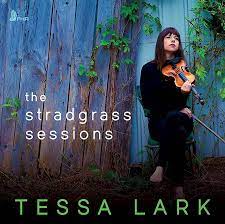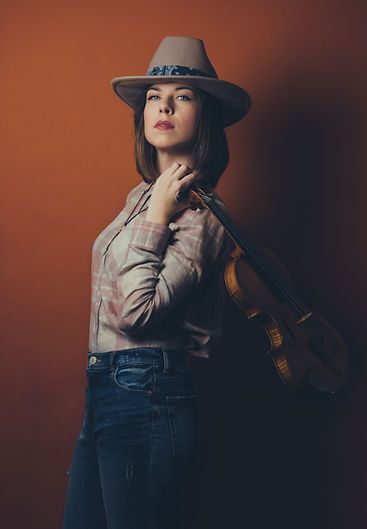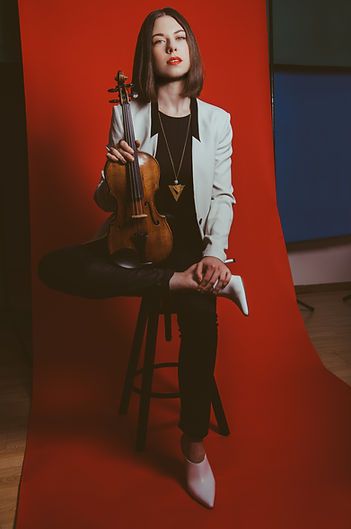Tessa Lark's The Stradgrass Sessions

This album is a snapshot of how I live in music; diversely, organically, intimately, sometimes collabroatively, sometimes solitarily, always sincerely - and anywhere, be it oncert hall or home studio
This is maverick violinist Tessa Lark's statement of intent for this her latest album. Whether in an esteemed concert hall (Wigmore Hall concert review) or taking us into new territories, Tessa Lark thinks outsde of the box.
Lark was born and raised in Kentucky, USA, and her earliest ifnfluences were bluegrass, Appalacian and other American folk styles. She is joined here by jazz pianist Jon Batiste, bassist Edgar Meyer, fiddle player Michael Cleveland and Mandolin player Sierra Hull.
It is obvious Lark is passionate about bluegrass. Here's a 34-minute video of her introducing the genre, and teaching string players how to do it:
... and here's the promo video for today’s disc:
Lark herself coined the term “Stradgrass” when, in 2015, she programmed bluegrass music played on her 1683 ex-Gingold Stradivarius violin (it was on loan; this album is actually played on her c. 1600 Maggini violin, itself on loan via the Stradivari Society of Chicago).
Lark’s own Jig and Pop (2022) includes the most hypnotic moto perpetuo:
Perhaps Hull's Chasin' Skies (2011) for violin and mandolin is more clearly what I expected from an album entitled Stradgrass, although the composer states they shifted it someway from bluegrass to "more of a funky, half-time feel":
Inspired by the piano opening of the “Blues” movement of the Ravel Violin Sonata, and also Martin Hayes and one of his bands, The Gloaming:it is called "Le Soka" as Lark was performing the Ravel at Soka University. The full title is Le Soka - Cheese in the Wine, the latter part referring to a tune she wrote on a plane:
A duo for violin and double-bass, Concert Duo by Edgar Meyer (and played by Lark and Meyer) is next. Two movements of four are presented here, the first of which is the more sombre, the second rapid and inspired by the mandolinist Sam Bush. Here's the first movement, so this post has nice contrast:
.. and here's a video of the second:

In the midst of this is Ysaÿe’s Sonata for Solo Violin in G, Op. 2/5, a performance of huge understanding, and virtuosity. The first movement is called “L’aurore” (the Dawn). As Lark says in her excellent notes, the first movement “leaves the listener feeling launched in flight”. She also says:
I can’t help but imagine the sun blazing from above the beautiful, wise Appalachian mountains f Eastern Kentucky
The second movement is marked “Danse rustique”; Lark equates this with all the qualities of a barn dance, which links it nicely to the main thrust of the disc:
As a parenthetical note, viola player Hana Gubenko has just recorded all six Ysaÿe Solo Sonatas on viola - and it's fabulous. I've put the Spotify links at the end of the post)
Lark's own Hysedelje (2022 - the word means noting - it is just the word that came out of Lark's mouth when she sang her own tune! (this time the melody dropped in while the coposer was riding on New York's subway):
One of Lark's heroes is Michael Cleveland, and they give us an example of what's called “twin fiddling,” an Old Time bluegrass practice. The result here is Lazy Katie (2018, to a tune by Cleveland) is beautiful, entrancing:

Corigliano's STOMP is a fascinating, virtuoso exposition of violin techniques (and yes, some foot stomping). It uses jazz/bluegrass themes and techniques, placing an unusual set of demands on the performer. They challenge the performer’s ear, their sense of style, and their co-ordination. The outer two strings are tuned to non-standard pitches (scordatura); it is modeled on American fiddle music (bluegrass and jazz); and, as we've noted, the player actually has rot use their feet as well. And let’s not forget there are some lyrical passages here, too:
A nice touch to include some Bartök Duos - here for violin and mandolin (Sierra Hull). The second included, simply called “Pizzicato” (Book IV, No. 43) is beautiful in this arrangement (there are three Duos performed in all):
Interesting, then, to hear a piano in the final track, Stephen Foster’s famous Old Kentucky Home (published in 1853). This a Meditation on “My Old Kentucky Home” and is arranged by Jon Batiste - the pianist in this recording - and Lark herself. This is incredibly haunting:
Lark's previous album, Fantasy, is also a joy (I reported on this a while ago for Classical Music magazine); and The Stradgrass Sessions is available at Amazon at a reduced price at he link below (11% off) as is Fantasy (14% off):
